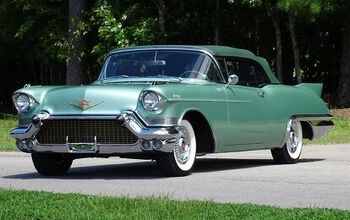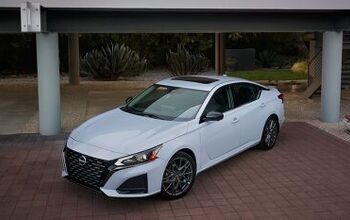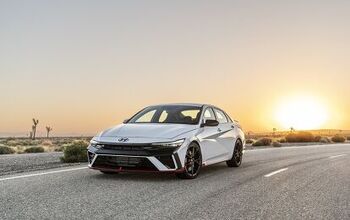General Motors Death Watch 119: Toyota Replaces GM as the World's Largest Automaker
“Our goal has never been to sell the most cars in the world.” For those who’ve been following GM’s fall from grace, this statement– following the revelation that GM has ceded its "world’s largest automaker" title to Toyota– probably comes as no surprise. Or maybe it does, because it arrived via Toyota spokesman Paul Nolasco. Or maybe it doesn’t. Toyota achieved this monumental victory by focusing on a process that led to a goal; whereas GM has been all about the money, for quite some time. And therein lies the tale.
You don’t need to compare long and short term business plans to understand the difference between Toyota and General Motors; although if you did, GM’s recent inability to devise a coherent platform strategy or develop a world class economy car would certainly give you pause for thought. All you have to do is sit in a few cars.
You can argue that the relative quality of GM's interior plastics don’t make no never mind. You could say that a four-speed gearbox is plenty of cogs, given their robust engineering, adequate performance and reasonable mileage. You could prevaricate over pushrods or defend GM's value-for-money vis-a-vis the competition. You could conclude that there isn’t any significant, appreciable difference between a current Toyota and an equivalent GM product. Not now. Not anymore. And you’d be wrong.
Don’t take my word for it. In the first three months of this year, Toyota sold 2.348m vehicles. In the same period, GM sold 2.26 million vehicles. All of these buyers had a choice. They chose Toyota over GM because they believed the Toyota product was superior. Yes, “believed.” Even if the “real” difference between a Toyota and a GM product exists entirely in their minds, well, it's still a product-related reality.
Automaking is not the French Revolution. GM can’t simply tell car buyers to forget the past, history starts here. No wait, here. OK, here. Consumers remember their past experiences with an automaker’s products. Just as a carmaker can build a reputation with years of consistent quality and service, bad quality and lousy service can destroy it by the same process, only faster.
Which is just as it should be, and exactly what GM has done. After years of alienating customers with shoddy, non-competitive products and indifferent (or worse) treatment, they’re reaping what they’ve sown. It’s a perfect example of a free market in action, or, if you prefer, simple Darwinism.
Here in the world’s biggest automotive marketplace, GM has provided a textbook example of de-evolution. When I started the GM Death Watch in April ’05, the company had a quiver full of domestic products ready to counter all those lingering bad vibes and “progress” its turnaround.
Including badge engineered products, GM launched the Saturn Sky, Aura and Outlook; Pontiac G5, Torrent and Solstice; Buick Enclave and Lucerne; Chevrolet HHR, Hummer H3 and Cadillac DTS. They updated the Chevrolet Tahoe, Suburban and Silverado; GMC Yukon and Sierra; and Cadillac Escalade.
While some of these models have created a buzz in the U.S. market, none has generated the predicted, mission critical market share uplift, or a return to profitability. How could they? With an estimated 7123 dealers for eight brands selling 42 models, no one model can possibly make up for the dogs, or significantly elevate earnings.
Meanwhile, in the same time period, Toyota has launched two new models: the Yaris and the FJ Cruiser. They’ve updated the Camry, Avalon, Tundra, RAV-4 and Lexus IS, ES, GS and LS. Toyota has less on its plate, and so (arguably) makes it better and (inarguably) keeps it fresher.
Why wouldn’t they? With 2422 dealers for three brands selling 30 models, the company has the development money, marketing budget, healthy dealer network and low cost structure it needs to stay ahead of the pack.
Make no mistake: Toyota knows exactly what it’s doing. It will continue on its current trajectory until GM’s world domination is a distant memory. Not that The General’s destruction is their goal. As company spokesman Nolasco said, "We simply want to be the best in quality. After that, sales will take care of themselves."
The truth is GM has cleared a path for Toyota. GM blurred its once proud brands through botched badge engineering, and then tried to fix the problem by adding brands rather than retrenching. Its fate was sealed. Given that GM’s now wearing two straitjackets– one with a union label and one enshrined in U.S. dealer franchise law– it cannot escape the consequences of its arrogance and short-sightedness. All that’s left is the unraveling.
More by Robert Farago
Latest Car Reviews
Read moreLatest Product Reviews
Read moreRecent Comments
- Dwford Will we ever actually have autonomous vehicles? Right now we have limited consumer grade systems that require constant human attention, or we have commercial grade systems that still rely on remote operators and teams of chase vehicles. Aside from Tesla's FSD, all these systems work only in certain cities or highway routes. A common problem still remains: the system's ability to see and react correctly to obstacles. Until that is solved, count me out. Yes, I could also react incorrectly, but at least the is me taking my fate into my own hands, instead of me screaming in terror as the autonomous vehicles rams me into a parked semi
- Sayahh I do not know how my car will respond to the trolley problem, but I will be held liable whatever it chooses to do or not do. When technology has reached Star Trek's Data's level of intelligence, I will trust it, so long as it has a moral/ethic/empathy chip/subroutine; I would not trust his brother Lore driving/controlling my car. Until then, I will drive it myself until I no longer can, at which time I will call a friend, a cab or a ride-share service.
- Daniel J Cx-5 lol. It's why we have one. I love hybrids but the engine in the RAV4 is just loud and obnoxious when it fires up.
- Oberkanone CX-5 diesel.
- Oberkanone Autonomous cars are afraid of us.


































Comments
Join the conversation
mikey: Since you are so obsessed with recall numbers, let's talk about them. Even though I don't think that's a good metric of quality---Honda recalled 1 million user mannuals last year. 2004: GM 10.8M Ford __5M, DCX 5.8M, Toyota 1.1M 2005: GM ___5M Ford __6M, DCX __1M, Toyota 2.2M 2006: GM _1.6M Ford 1.7M, DCX 2.4M, Toyota 0.8M In any given year, Toyota's recalls are less than half of the GM or Ford recalls. Given the one-shot nature of the recalls, it makes more sense to compare a moving average line of one model cycle (i.e. 4 or 8 years) and then read the results.
Well put article, Robert. I remember to this day the GM District Manager telling he wasn't warranting my 2 year old Buick Century when the front wheel fell off saying "we won't warrant your car because I can't believe the car left our factory this way, you must have tampered with it". That is the last GM car I and my family will EVER buy and the last they will see of my car. I realize now that I am not alone in matters like this. Though I am not a fan of Toyotas (I've had problems with them too), it's good to see a company know where their problems are and work to resolve them regardless of the bottom line. A company that doesn't build product just to be competitive but to be the best at what they do, deserves to be in business and at the number one position too.